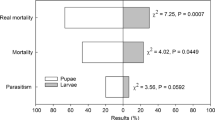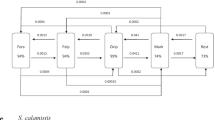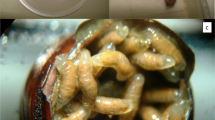Abstract
A kairomone in the frass and vomitus of larvae ofAgrotis ipsilon (Hufnagel) (Lepidoptera: Noctuidae) triggered larviposition activity in its habitual parasitoidBonnetia comta (Fallen) (Diptera: Tachinidae). Laboratory bioassays showed that no measurable differences existed in the larviposition-stimulating activity of frass fromA. ipsilon larvae reared on 3 different food sources. In other tests, corn seedlings damaged by late-instar larvae ofA. ipsilon elicited strong larviposition activity inB. comta; other corn seedlings damaged with a razor blade did not elicit strong activity. Frass aged for 8-days was only slightly less effective at releasing a larviposition response when compared to fresh frass.B. comta was not stimulated to larviposit by oven dried frass or an India ink dot the color and shape of a fresh pellet from a host larva. The host habitat location and host finding process forB. comta and other tachinid species that deposit free-living maggots is discussed.
Résumé
Une kairomone localisée dans les fécès et les régurgitations des larves d'Agrotis ipsilon (Hufnagel) [Lepideptora: Noctuidae] d['eclenchait l'activité de ponte chez son parasitoïde habituelBonnetia comta (Fallén) [Diptera Tachinidae]. Des titrages biologiques de laboratoire montraient qu'il n'existait pas de différences mesurables dans l'activité stimulant la ponte des fécès larvaires d'A. ipsilon élevé sur trois sources de nourritures différentes. Dans d'autres essais des semis de maïs endommagés par les derniers stades larvaires d'A. ipsilon provoquaient une forte activité de ponte chezB. comta; d'autres semis de maïs endommagés avec une lame de rasoir ne provoquaient pas de réaction comparable. Des fécès âgés de 8 jours étaient juste un peu moins efficaces à déclencher un réflexe de ponte que comparativement des fécès frais.B. comta n'était pas incité à pondre par des fécès séchés au four ou un point d'encre de Chine imitant par la couleur et la forme une partie des fécès frais de la larve. La localisation de l'habitat de l'hôte et le processus de recherche de l'hôte chezB. comta et les autres espèces de Tachinaires qui expulsent des larves néonates vivantes sont discutés.
Similar content being viewed by others
References
Arnaud, P.H., Jr. — 1978. A host-parasite catalog of North American Tachinidae [Diptera]. —Misc. Pub., No. 13129, SEA, USDA, 860 p.
Brown, W.L., Jr., Eisner, T. &Whittaker, R.H. — 1970. Allomones and kairomones: Transspecific chemical messengers. —Bio-Science, 20, 21–22.
Busching, M.K. &Turpin, F.T. — 1977. Survival and development of black cutworm [Agrotis ipsilon] larvae on various species of crop plants and weeds. —Environ. Entomol., 6, 63–65.
Clement, S.L. &McCartney, D.A. — 1982. Black cutworm [Lepidoptera: Noctuidae]: measurement of larval feeding parameters on field corn in the greenhouse. —J. Econ. Entomol., 75, 1005–1008.
Crumb, S.E. — 1929. Tobacco cutworms —USDA Tech. Bull., No. 88, 180 p.
Crumb, S.E. — 1956. The larvae of thePhalaenidae. — USDA Tech. Bull., No. 1135, 356 p.
Franklin, R.T. &Holdaway, F.G. — 1966. A relationship of the plant to parasitism of European corn borer by the tachinid parasiteLydella grisescens. —J. Econ. Entomol., 59, 440–441.
Hsiao, T.H., Holdaway, F.G. &Chiang H.C.. — 1966. Ecological and physiological adaptations in insect parasitism. —Entomol. Exp. Appl., 9, 113–123.
Levine, E., Clement, S.L. &McCartney, D.A. — 1981. Agronomic practices influence black cutworm damage on corn. —Ohio Report, 66, 29–30.
Levine, E. &Clement, S.L. — 1981a. Effect of parasitism byBonnetia comta [Diptera: Tachinidae] on larvae ofAgrotis ipsilon [Lepidoptera: Noctuidae]. —J. Kansas Entomol. Soc., 54, 219–222.
Levine, E. &Clement, S.L. — 1981b. A laboratory method for rearingBonnetia comta [Diptera: Tachinidae]. —Pan. Pac. Entomol., 57, 347–350.
Levine, E., Clement, S.L. &Schmidt, R.S. — 1982. A low cost and labor efficient method for rearing black cutworms [Lepidoptera: Noctuidae]. —Great Lakes Entomol., 15, 47–48.
Luckmann, W.H. — 1978. Insect control in corn-practices and prospects. In: Pest Control Strategies (E.H. Smith &D. Pimentel, eds). —Academic Press, New York, 137–155.
Mulder, P.G., Jr &Showers, W.B. — 1983. Feeding on corn by black cutworm [Lepidoptera: Noctuidae] larvae reared for one or multi-generations in the laboratory. —Environ. Entomol., 12, 340–344.
Nettles, W.C., Jr. &Burks, M.L. — 1975. A substance fromHeliothis virescens larvae stimulating larviposition by females of the tachinid,Archytas marmoratus. —J. Insect Physiol., 21, 965–978.
Nielsen, D.G., Purrington, F.F., Shambaugh, G.F. &Musick, G.J. — 1979. RearingPodesesia larvae on a meridic diet. —J. Georgia Entomol. Soc., 15, 37–41.
Nordlung, D.A., Jones, R.L. &Lewis, W.J. (eds). — 1981. Semiochemicals, Their Role in Pest Control. —John Wiley & Sons, New York, 306 p.
Okumura, G.T. — 1961. Identification of lepidopterous larvae attacking cotton. —Special Pub., 282, State of Calif. Dept. Agric., 80 p.
Price, P.W. — 1981. Semiochemicals in evolutionary time. In: Semiochemicals, Their Role in Pest Control (D.A. Nordlund, R.L. Jones &W.J. Lewis eds.). —John Wiley & Sons, New York, 251–279.
Rings, R.W., Arnold, F.J., Keaster, A.J. & Musick, G.J. — 1974. A world wide, annotated bibliography of the black cutworm. —Ohio Agr. Res. Dev. Ctr., Res. Circ., 198, 106 p.
Roth, J.P., King, E.G. &Thompson, A.C. — 1978. Host location behavior by the tachinid,Lixophaga diatraeae. —Environ. Entomol., 7, 794–798.
Roth, J.P., King, E.G. &Hensley, S.D. — 1982. Plant, host, and parasite interactions in the host selection sequence of the tachinidLixophaga diatraeae. —Environ. Entomol., 11, 273–277.
Rubink, W.L. &Clement, S.L. — 1982. Reproductive biology ofBonnetia comta (Fallen) [Diptera: Tachinidae], a parasitoid of the black cutworm,Agrotis ipsilon (Hufnagel), [Lepidoptera: Noctuidae].Environ. Entomol., 11, 981–985.
Ryan, T.A., Joiner, B.L. &Ryan, B.F. — 1976. Minitab Student Manual.Duxbury Press. North Scituate, Mass., 341 p.
Sajap, A.S.B., Beegle, C.C. &Lewis, L.D. — 1978. Effect of parasitism byMicroplitis kewleyi on the cutting ability of its host,Agrotis ipsilon. —Environ. Entomol., 7, 343–344.
Sandlan, K.P., Jones, R.L. &Chiang, H.C. — 1983. Influence of density of the European corn borer,Ostrinia nubilalis, [Lepidoptera: Pyralidae] on the parasitoidLydella thompsoni [Diptera: Tachinidae]. —Environ. Entomol., 12, 174–177.
Sauls, C.E., Nordlund, D.A. &Lewis, W.J. — 1979. Kairomones and their use for management of entomophagous insects. VIII. Effect of diet on the kairomonal activity of frass fromHeliothis zea (Boddie) larvae forMicroplitis croceipes (Cresson). —J. Chem. Ecol., 5, 363–369.
Schoenbohm, R.B. &Turpin, F.T. — 1977. Effect of parasitism byMeteorus leviventris on corn foliage consumption and corn seedling cutting by the black cutworm. —J. Econ. Entomol., 70, 457–459.
Seamans, H.L. &McMillan, E. — 1935. The effect of food plants on the development of the pale western cutworm (Agrotis orthogonia). —J. Econ. Entomol., 28, 421–425.
Strickland, E.H. — 1912. Parasites of the pale western cutworm in Alberta. —Can. Entomol., 53, 97–100.
Strickland, E.H. — 1923. Biological notes on parasites of prairie cutworms. —Can. Dept. Agric., Entomol. Bull., No. 22, 40 p.
Thompson, A.C., Roth, J.P. &King, E.G. — 1983. Larviposition kairomone of the tachinidLixophaga diatraeae. —Environ. Entomol., 12, 1312–1314.
Vinson, S.B. — 1977. Behavioral chemicals in augmentation of natural enemies. In: Biological Control by Augmentation of Natural Enemies (R.L. Ridgway &S.B. Vinson, eds.). —Plenum Press, New York, 237–279.
Weseloh, R.M. — 1981. Host location by parasitoids. In: Semiochemicals. Their Role in Pest Control (D.A. Nordlund, R.L. Jones &W.J. Lewis, eds.). —John Wiley & Sons, New York, 79–95.
Yang, W., Kuo, C.Y. &Yeh, T.F. — 1965. Biological studies onLinnaemyia compta Fallen [Diptera: Larvaevoridae]. —Acta Entomol. Sinica, 14, 159–177.
Author information
Authors and Affiliations
Additional information
Approved for publication as Journal Article No. 163-84 of The Ohio State University and The Ohio Agricultural Research and Development Center. This work was supported in part by U.S. Environmental Protection Agency grant R-805429.
Rights and permissions
About this article
Cite this article
Clement, S.L., Rubink, W.L. & McCartney, D.A. Larviposition response ofBonnetia comta [Dipt.: Tachinidae] to a kairomone ofAgrotis ipsilon [Lep.: Noctuidae] . Entomophaga 31, 277–284 (1986). https://doi.org/10.1007/BF02373337
Received:
Accepted:
Issue Date:
DOI: https://doi.org/10.1007/BF02373337




